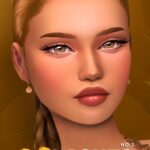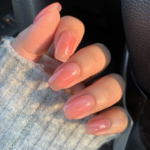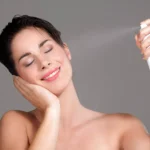Some people think that beards and mustaches are like special decorations that make men look more manly. Many famous athletes, singers, and actors are working hard to have the coolest beard and mustache. Some of the celebrities who have made beards really popular are Brad Pitt, Idris Elba, and Bad Bunny. It’s not just about following the trend – some people like how beards change the way their face looks. Others grow beards because they don’t like shaving every day; it can be annoying and make their skin feel irritated.
But not everyone can grow a full and regular beard. Some people use a substance called minoxidil, which has been used by those dealing with hair loss. What exactly is minoxidil, and does it really help with growing beards? We’ll answer these questions and more in our latest article. Let’s get started!
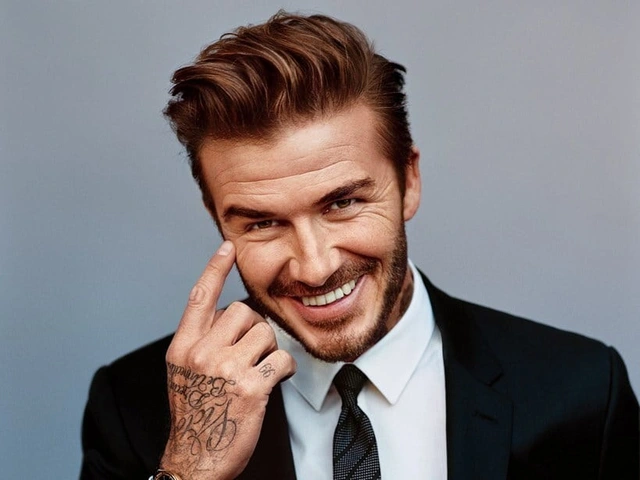
What is Minoxidil?
Minoxidil, FDA-approved for treating hair loss and promoting hair regrowth, initially launched as a prescription medication called Rogaine in 1987. It’s now available without a prescription in foam or serum forms and can also be taken orally.
While minoxidil was originally intended for thinning hair and baldness on the scalp, it’s increasingly being used off-label to boost beard growth. According to trichologist and hair loss expert Precious Rutlin, consistent use of minoxidil has proven effective in helping some individuals regrow their hair, as demonstrated in clinical studies. However, she emphasizes that individual results may vary.
How does minoxidil work?
Research led by Jason Emer, a certified skin doctor in Los Angeles, explained that when minoxidil is used to widen blood vessels, it works by opening specific channels in muscle cells. This widening effect might boost the health of hair cells or follicles.
Dr. Dandy Engelman, MD, FACMS, FAAD, a board-certified cosmetic dermatologist, and Mohs surgeon at New York City’s Shafer Clinic said that minoxidil has been proven to be a beneficial method for enhancing hair growth. It fosters the circulation of oxygen, blood, and nutrients to the hair follicle, fortifying the follicle and promoting hair growth. Its primary application is to stimulate hair growth and impede the progression of balding.
Is minoxidil good for beard growth?
Scientists did some studies on using minoxidil to grow beards, and the results look good. Even though they haven’t studied it as much for beards as they have for head hair, the research suggests that minoxidil can make beards thicker and fuller. Putting minoxidil on areas with facial hair, like your beard and mustache, seems to work well for people wanting more facial hair.
It’s essential to know that using minoxidil for beard growth isn’t what it was made for. It’s like using something in a way that wasn’t originally planned. Like any medicine, everyone might react differently, and there could be side effects. Some people might get irritated skin, dryness, or redness when they put on the minoxidil. Following the right amount and how to put it on is crucial to avoid problems.
Before you start using minoxidil on your beard, it’s smart to talk to a doctor or a skin specialist. They can give you advice that fits your health history and check if there’s anything that could cause issues. Even though minoxidil seems like a good choice for a thicker beard, it’s also important to do other things, like taking care of your skin, eating well, and staying healthy overall. All these things together will give you the best results.
How to use Minoxidil
To get the best beard growth results, follow all of the following steps
Step 1: Cleanse and Dry Your Face
Wash your face with a gentle cleanser to remove any dirt, oil, or sweat. Pat your face dry with a clean towel.
Ensure your face is completely dry before applying minoxidil, as moisture can dilute the product and reduce its effectiveness.
Step 2: Apply Minoxidil Directly to the Beard Area
Use the dropper or applicator provided with the minoxidil solution to apply a small amount (approximately 1 mL) directly to your beard area.
Focus on areas where you want to promote hair growth, such as the cheeks, chin, and neckline. Use your fingertips to gently massage the minoxidil into your skin. Make sure the solution reaches the base of your hair follicles. Do not apply minoxidil to your eyes, lips, or any other areas of your face besides your beard.
Step 3: Let the Minoxidil Dry Completely
Let minoxidil dry completely on your skin before applying any other products, such as moisturizer or sunscreen. This process usually takes about 10-15 minutes. Try to let the minoxidil dry on the skin for that duration; otherwise, it won’t have the greatest impact on the skin.
Step 4: Repeat the Process Twice Daily
Apply minoxidil twice a day, once in the morning and once at night. Consistency is key to achieving results. Aim to apply the minoxidil at the same time each day to maximize its effectiveness. Minoxidil is a treatment that needs to be applied daily for good long-term results.
Minoxidil for beards: Before and after results
Some people use minoxidil to help with their beard growth when they have challenges like a beard that’s not very full or has patches. Maybe their natural beard growth is not a lot, and they want a thicker, fuller beard to make their face look better. So, they try minoxidil to see if it can make a difference in how their facial hair looks.
People who use minoxidil regularly often see significant changes in their before-and-after pictures. Minoxidil helps new hair grow, making the beard denser, especially in areas where there wasn’t much hair before. Users often notice that their beard looks better and thicker, giving their face a more even and grown-up look. While everyone’s experience is different, and it takes time, the changes seen in before-and-after pictures show that minoxidil could be a good choice for those who want a fuller beard and a more satisfying facial hair look.
You can refer to some pictures before and after using Minoxidil.
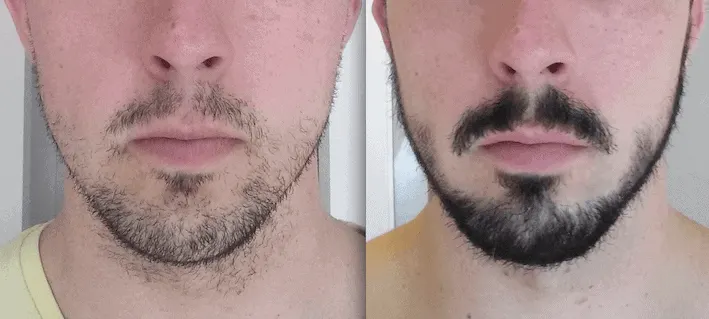
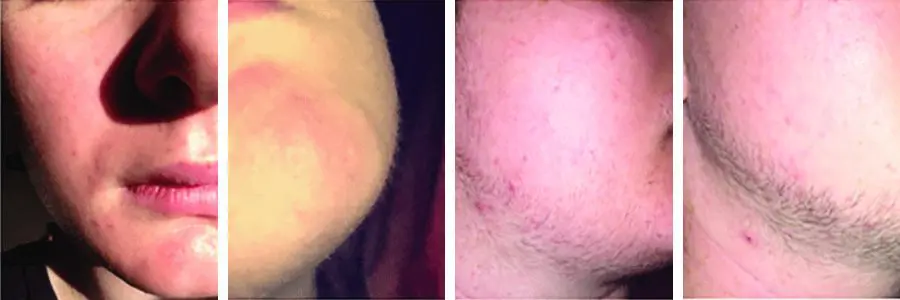
Beard growth before Minoxidil treatment; after 2 months; after 3 months; after 5 months
Are there any side effects of using minoxidil for beard growth?
Yes, while it is generally safe and well-tolerated, it can cause some unwanted effects in some people.The usual problem people mention is skin irritation. Some other common issues are itching and flaking. Sometimes, hair might unexpectedly grow in places where you didn’t use the minoxidil.
Certain types of minoxidil have something called propylene glycol (PG), which helps minoxidil dissolve better. This makes it easier for minoxidil to get into the hair follicles. However, PG can be annoying, so they made a version without it called minoxidil foam. It goes on quicker, doesn’t spread as much, and is more comfortable to use.
Even though a bit of minoxidil can get into your body when you put it on your scalp, it’s not much (about 1.4%). Minoxidil doesn’t stick to the proteins in your blood or go into your brain, and most of it leaves your body through your kidneys within 4 days.
People have been using minoxidil for a long time to treat hair loss on the scalp for conditions like androgenetic alopecia. There haven’t been many reports of long-term issues with using minoxidil for these conditions.
Who Should Avoid Minoxidil?
Experts say that if your skin is sensitive or if you have ongoing skin issues like eczema or psoriasis, you need to be careful when using minoxidil to grow a beard. Dr. Engelman, a board-certified cosmetic dermatologist advised: “If you have sensitive skin or skin conditions, it’s important to be cautious. Before you start using minoxidil, do a patch test. Keep a close eye on your skin while using it, and if you notice any issues, stop using it.”
What about using minoxidil along with your other skincare routine? Dr. Engelman said it’s okay to clean and exfoliate your skin before using minoxidil. However, she added, “If your skin is sensitive, be careful with exfoliating because it can make your skin more sensitive to minoxidil.”
FAQ
1. Does minoxidil grow a permanent beard?
As of now, there is no scientific evidence indicating that minoxidil-induced beards will persist permanently once the treatment is discontinued. Achieving a full beard is a gradual process, with many men not realizing their complete beard potential until their mid-30s.
2. Can a 17 year old use minoxidil for beard?
Minoxidil seems to be well-tolerated in individuals under 18. A study involving 13 boys, aged 13 to 17 years (mean age, 15.9 years), experiencing early male balding, affirmed the safety of minoxidil in this age group through an open-label investigation.
3. What happens if I stop using minoxidil?
If you quit using minoxidil, you might lose the hair you gained or kept while using the medicine. Minoxidil only helps when you use it, and once you stop, your hair follicles will go back to their usual growth pattern, causing potential hair loss.
4.Is there a better option than minoxidil?
You can consider other options instead of minoxidil, like finasteride, spironolactone, or laser therapy. Look into these choices to find what might be best for you based on your needs and preferences.
5. Can I skip minoxidil for a week?
Although skipping won’t harm your hair, it will make the medicine less effective. It’s usually okay to miss a dose now and then, but skipping once a week will make them less effective.
Conclusion
Beard growth with minoxidil has emerged as a promising solution for stimulating, offering hope to countless individuals seeking a fuller, more defined beard. While results may vary depending on individual factors, the potential for significant growth is undeniable. However, remember that consistency and patience are key. It’s a journey, not a destination. Be kind to your skin, monitor progress, and embrace the gradual transformation. With dedication and the right approach, Minoxidil can help you unlock the beard-growing potential you’ve always desired.

